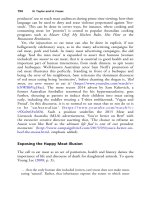The palgrave international handbook of a 479
Bạn đang xem bản rút gọn của tài liệu. Xem và tải ngay bản đầy đủ của tài liệu tại đây (27.32 KB, 1 trang )
Animals in War
481
The cavalry, made powerful by the steppe inhabitants, became crucial to
most of the remaining history of war, right up to the shocks of World War I,
when new machinery and tactics radically curtailed the effectiveness of
cavalry, even if horses remained important. The massive scale and character
of more recent wars has resulted in much more direct forms of abuse and
suffering for horses. Kistler writes, for instance, about Napoleon’s campaign
against Russia in 1812, calling it ‘an utter disaster’ (2011, p. 144). DiMarco
notes that the French rode into Russia in summer with some 80,000 horses,
but forage was not to be found. The French lost 8,000 horses in the first
eight days, ‘mostly from lack of care’ (2008, p. 208). The French nonetheless
made their way to Moscow in September, writes DiMarco, but facing winter,
‘Napoleon decided to withdraw [ . . . ] and began one of the longest and most
desperate retreats in military history’. One night ‘the cold was so intense that
30,000 horses died’, horses who then became meat for the starving soldiers
(2008, p. 208). Kistler describes soldiers eating horse blood pudding, horse
hearts and livers, and half-cooked horse meat of other kinds (2011, p. 145).
In such scenarios, the many logistical exigencies and challenges of war cause
more horse (and human) suffering than the actual fighting.
DiMarco aligns such episodes with larger issues in the nineteenth-century
French cavalry. He writes that ‘military horsemanship took a definite turn for
the worse during the Napoleonic period due to the large size of the armies,
the high number of casualties, and the constant warfare’ (2008, p. 214).
Riders received too little training, resulting in poorly treated horses, and
exhaustion took its toll on men and animals both (2008, p. 214). Under such
conditions, soldiers resisted in ways that often fell hard on the horses.
DiMarco remarks how commonly the horses experienced saddle sores, and
he notes efforts by some people to ‘shirk duty by intentionally injuring their
horse[s]’ by placing ‘stones or even tacks under the saddle to cause back sores
and thus eliminate horse and rider from duty’ (2008, p. 216).
Similar patterns emerged in the U.S. Civil War (1861–1865) where,
Kistler reports, inexperienced and unknowing Union soldiers gravely harmed
or crippled their horses by overworking or overfeeding them (2011, p. 164).
Such systematized warfare has many vulnerable points that bear on horses.
DiMarco, for instance, writes about corruption besetting the Union’s efforts
to buy horses for use in the war. One of his representative examples involved
a purchase of 400 horses; ‘five died within hours of the sale, and 300 others
were smaller than the standard, lame, blind, or sick’ (2008, p. 241). These
animals would be particularly ill-suited to the challenges of war and all the
more likely to suffer injury or death. Also, the perennial problem of horse
feed in war plagued the Union. In one case, President Lincoln’s order to









